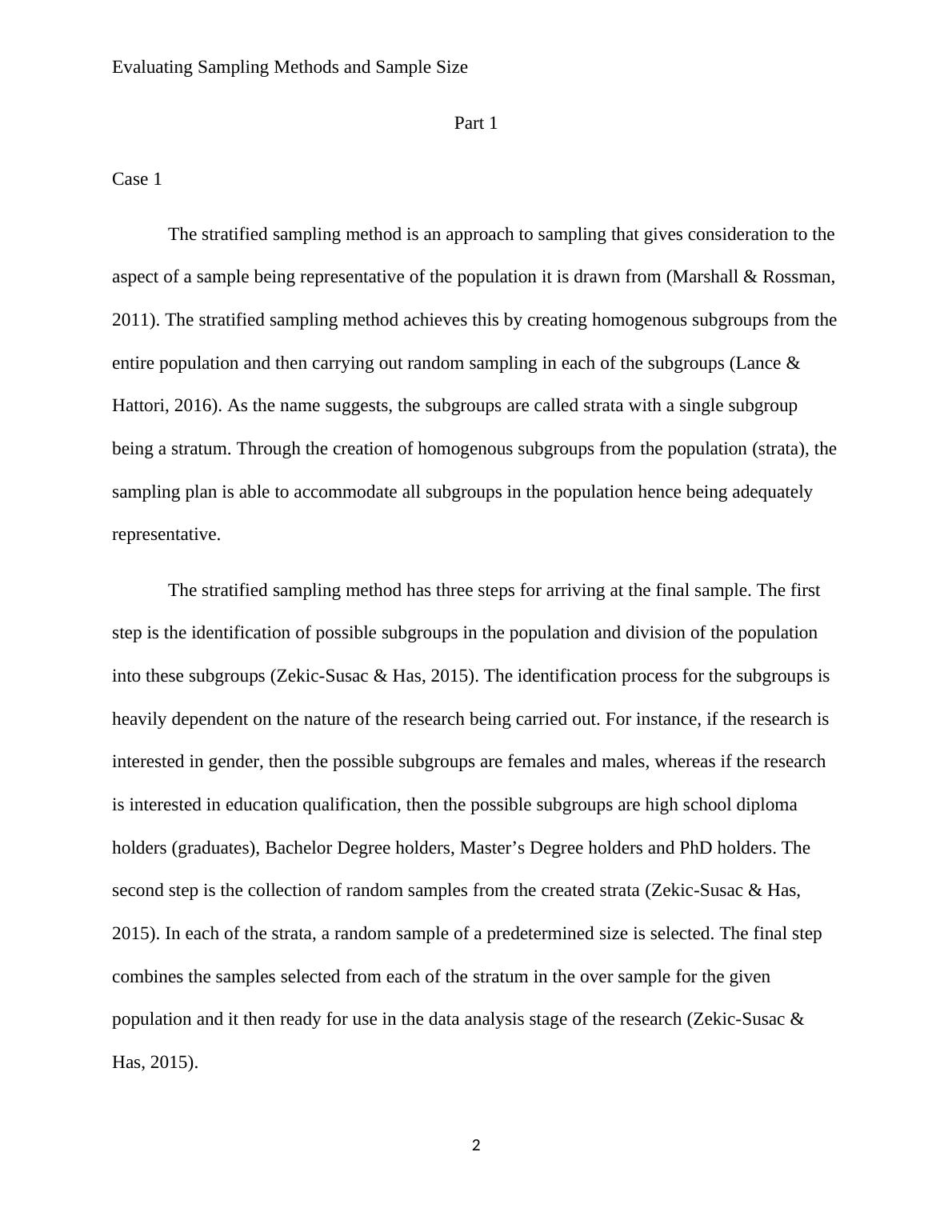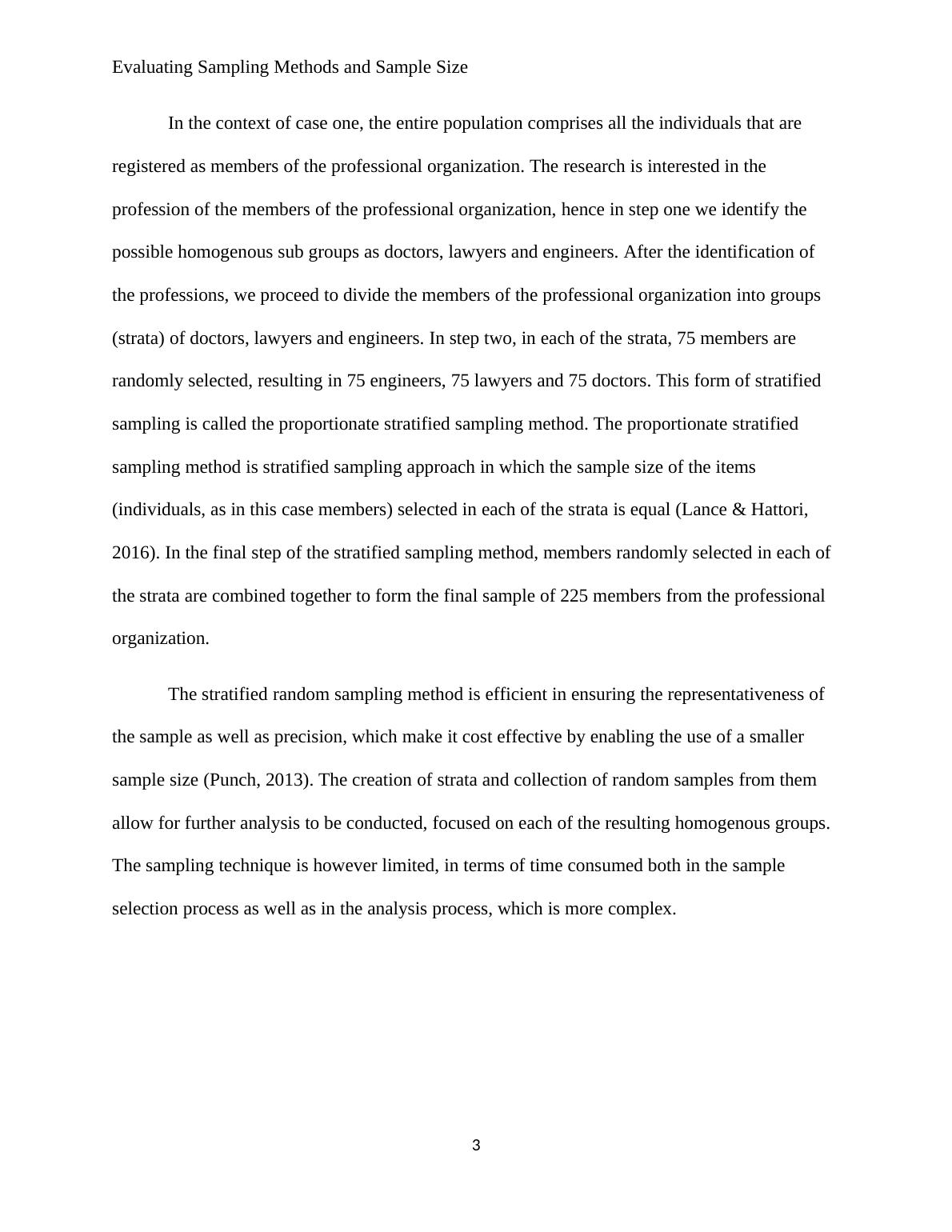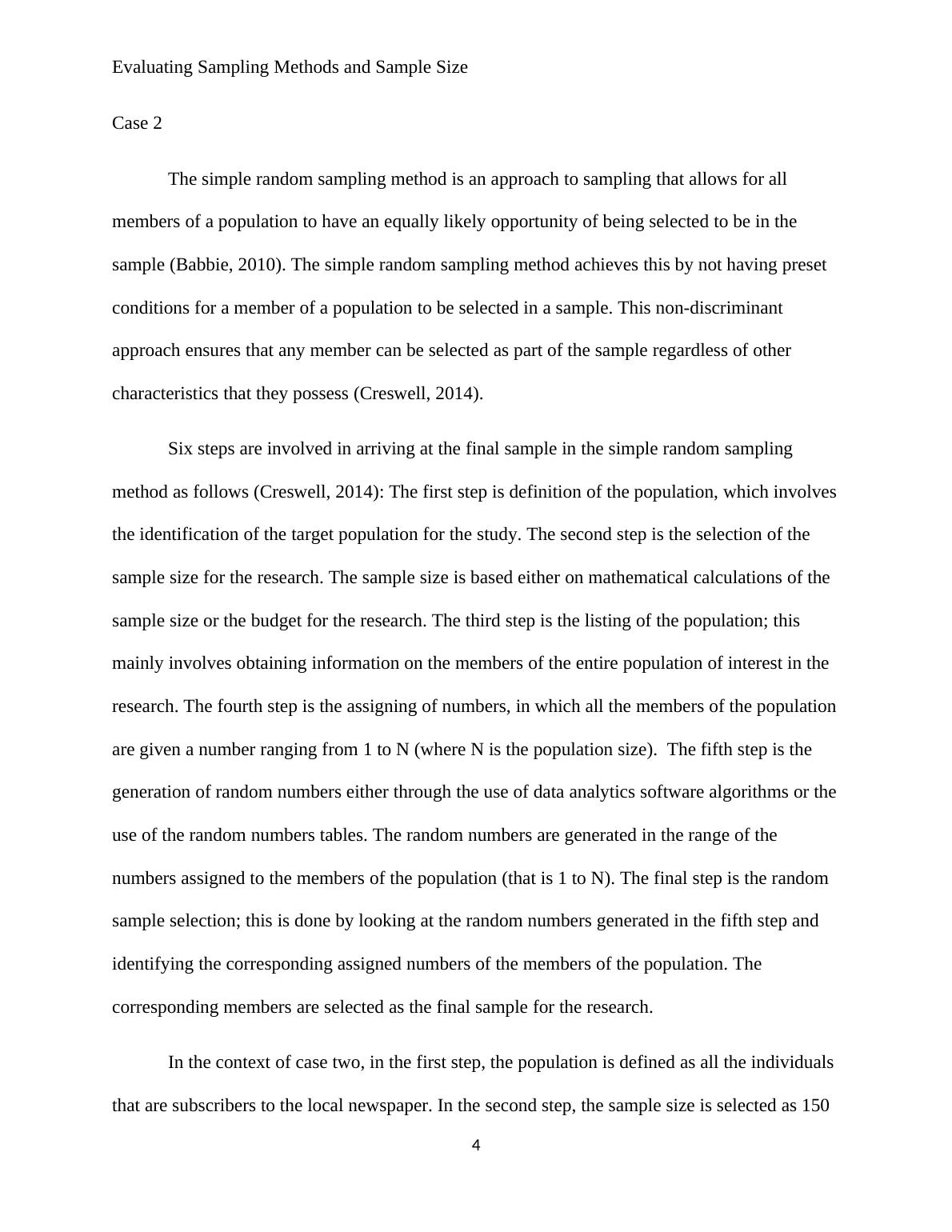Evaluating Sampling Methods and Sample Size | Cases
Added on 2022-08-18
13 Pages3099 Words16 Views
Evaluating Sampling Methods and Sample Size

Evaluating Sampling Methods and Sample Size
Part 1
Case 1
The stratified sampling method is an approach to sampling that gives consideration to the
aspect of a sample being representative of the population it is drawn from (Marshall &
Rossman, 2011). The stratified sampling method achieves this by creating homogenous
subgroups from the entire population and then carrying out random sampling in each of the
subgroups (Lance & Hattori, 2016). As the name suggests, the subgroups are called strata with
a single subgroup being a stratum. Through the creation of homogenous subgroups from the
population (strata), the sampling plan is able to accommodate all subgroups in the population
hence being adequately representative.
The stratified sampling method has three steps for arriving at the final sample. The first
step is the identification of possible subgroups in the population and division of the population
into these subgroups (Zekic-Susac & Has, 2015). The identification process for the subgroups
is heavily dependent on the nature of the research being carried out. For instance, if the research
is interested in gender, then the possible subgroups are females and males, whereas if the
research is interested in education qualification, then the possible subgroups are high school
diploma holders (graduates), Bachelor Degree holders, Master’s Degree holders and PhD
holders. The second step is the collection of random samples from the created strata (Zekic-
Susac & Has, 2015). In each of the strata, a random sample of a predetermined size is selected.
The final step combines the samples selected from each of the stratum in the over sample for the
given population and it then ready for use in the data analysis stage of the research (Zekic-
Susac & Has, 2015).
2
Part 1
Case 1
The stratified sampling method is an approach to sampling that gives consideration to the
aspect of a sample being representative of the population it is drawn from (Marshall &
Rossman, 2011). The stratified sampling method achieves this by creating homogenous
subgroups from the entire population and then carrying out random sampling in each of the
subgroups (Lance & Hattori, 2016). As the name suggests, the subgroups are called strata with
a single subgroup being a stratum. Through the creation of homogenous subgroups from the
population (strata), the sampling plan is able to accommodate all subgroups in the population
hence being adequately representative.
The stratified sampling method has three steps for arriving at the final sample. The first
step is the identification of possible subgroups in the population and division of the population
into these subgroups (Zekic-Susac & Has, 2015). The identification process for the subgroups
is heavily dependent on the nature of the research being carried out. For instance, if the research
is interested in gender, then the possible subgroups are females and males, whereas if the
research is interested in education qualification, then the possible subgroups are high school
diploma holders (graduates), Bachelor Degree holders, Master’s Degree holders and PhD
holders. The second step is the collection of random samples from the created strata (Zekic-
Susac & Has, 2015). In each of the strata, a random sample of a predetermined size is selected.
The final step combines the samples selected from each of the stratum in the over sample for the
given population and it then ready for use in the data analysis stage of the research (Zekic-
Susac & Has, 2015).
2

Evaluating Sampling Methods and Sample Size
In the context of case one, the entire population comprises all the individuals that are
registered as members of the professional organization. The research is interested in the
profession of the members of the professional organization, hence in step one we identify the
possible homogenous sub groups as doctors, lawyers and engineers. After the identification of
the professions, we proceed to divide the members of the professional organization into groups
(strata) of doctors, lawyers and engineers. In step two, in each of the strata, 75 members are
randomly selected, resulting in 75 engineers, 75 lawyers and 75 doctors. This form of stratified
sampling is called the proportionate stratified sampling method. The proportionate stratified
sampling method is stratified sampling approach in which the sample size of the items
(individuals, as in this case members) selected in each of the strata is equal (Lance & Hattori,
2016). In the final step of the stratified sampling method, members randomly selected in each of
the strata are combined together to form the final sample of 225 members from the professional
organization.
The stratified random sampling method is efficient in ensuring the representativeness of
the sample as well as precision, which make it cost effective by enabling the use of a smaller
sample size (Punch, 2013). The creation of strata and collection of random samples from them
allow for further analysis to be conducted, focused on each of the resulting homogenous groups.
The sampling technique is however limited, in terms of time consumed both in the sample
selection process as well as in the analysis process, which is more complex.
3
In the context of case one, the entire population comprises all the individuals that are
registered as members of the professional organization. The research is interested in the
profession of the members of the professional organization, hence in step one we identify the
possible homogenous sub groups as doctors, lawyers and engineers. After the identification of
the professions, we proceed to divide the members of the professional organization into groups
(strata) of doctors, lawyers and engineers. In step two, in each of the strata, 75 members are
randomly selected, resulting in 75 engineers, 75 lawyers and 75 doctors. This form of stratified
sampling is called the proportionate stratified sampling method. The proportionate stratified
sampling method is stratified sampling approach in which the sample size of the items
(individuals, as in this case members) selected in each of the strata is equal (Lance & Hattori,
2016). In the final step of the stratified sampling method, members randomly selected in each of
the strata are combined together to form the final sample of 225 members from the professional
organization.
The stratified random sampling method is efficient in ensuring the representativeness of
the sample as well as precision, which make it cost effective by enabling the use of a smaller
sample size (Punch, 2013). The creation of strata and collection of random samples from them
allow for further analysis to be conducted, focused on each of the resulting homogenous groups.
The sampling technique is however limited, in terms of time consumed both in the sample
selection process as well as in the analysis process, which is more complex.
3

Evaluating Sampling Methods and Sample Size
Case 2
The simple random sampling method is an approach to sampling that allows for all
members of a population to have an equally likely opportunity of being selected to be in the
sample (Babbie, 2010). The simple random sampling method achieves this by not having
preset conditions for a member of a population to be selected in a sample. This non-discriminant
approach ensures that any member can be selected as part of the sample regardless of other
characteristics that they possess (Creswell, 2014).
Six steps are involved in arriving at the final sample in the simple random sampling
method as follows (Creswell, 2014): The first step is definition of the population, which
involves the identification of the target population for the study. The second step is the selection
of the sample size for the research. The sample size is based either on mathematical calculations
of the sample size or the budget for the research. The third step is the listing of the population;
this mainly involves obtaining information on the members of the entire population of interest in
the research. The fourth step is the assigning of numbers, in which all the members of the
population are given a number ranging from 1 to N (where N is the population size). The fifth
step is the generation of random numbers either through the use of data analytics software
algorithms or the use of the random numbers tables. The random numbers are generated in the
range of the numbers assigned to the members of the population (that is 1 to N). The final step is
the random sample selection; this is done by looking at the random numbers generated in the
fifth step and identifying the corresponding assigned numbers of the members of the population.
The corresponding members are selected as the final sample for the research.
In the context of case two, in the first step, the population is defined as all the individuals
that are subscribers to the local newspaper. In the second step, the sample size is selected as 150
4
Case 2
The simple random sampling method is an approach to sampling that allows for all
members of a population to have an equally likely opportunity of being selected to be in the
sample (Babbie, 2010). The simple random sampling method achieves this by not having
preset conditions for a member of a population to be selected in a sample. This non-discriminant
approach ensures that any member can be selected as part of the sample regardless of other
characteristics that they possess (Creswell, 2014).
Six steps are involved in arriving at the final sample in the simple random sampling
method as follows (Creswell, 2014): The first step is definition of the population, which
involves the identification of the target population for the study. The second step is the selection
of the sample size for the research. The sample size is based either on mathematical calculations
of the sample size or the budget for the research. The third step is the listing of the population;
this mainly involves obtaining information on the members of the entire population of interest in
the research. The fourth step is the assigning of numbers, in which all the members of the
population are given a number ranging from 1 to N (where N is the population size). The fifth
step is the generation of random numbers either through the use of data analytics software
algorithms or the use of the random numbers tables. The random numbers are generated in the
range of the numbers assigned to the members of the population (that is 1 to N). The final step is
the random sample selection; this is done by looking at the random numbers generated in the
fifth step and identifying the corresponding assigned numbers of the members of the population.
The corresponding members are selected as the final sample for the research.
In the context of case two, in the first step, the population is defined as all the individuals
that are subscribers to the local newspaper. In the second step, the sample size is selected as 150
4

End of preview
Want to access all the pages? Upload your documents or become a member.
Related Documents
Assignment on Sampling and G Power Analysislg...
|11
|2421
|21
Sampling, Hypothesis Testing, and Regressionlg...
|8
|1706
|608
Sampling, Hypothesis Testing, and Regressionlg...
|8
|1706
|278
Research Article Appraisallg...
|20
|3950
|82
Grounds for Probability and Non-Probability Sampling Case Study 2022lg...
|5
|1042
|22
